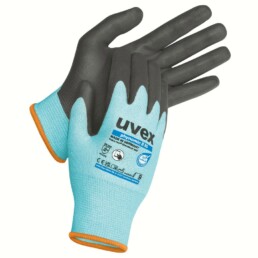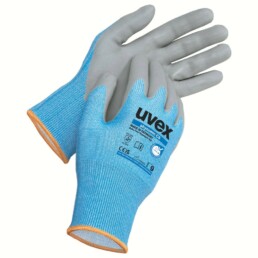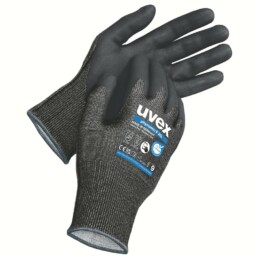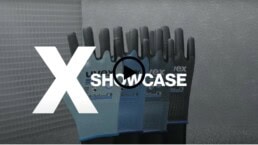Anyone who works with sharp-edged objects needs to protect their hands. The gloves of choice are cut protection gloves. Find out here which materials make them cut-resistant, which standard they have to fulfil and what makes uvex models stand out.
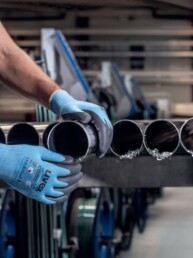
Hands particularly at risk
The German Social Accident Insurance publishes a highly regarded document once a year: the statistics on accidents at work. For number crunchers and safety engineers alike, this is a revealing document, as it provides fascinating insights into the world of occupational safety. Among other things, it reveals that men are affected by accidents at work more than twice as often as women. And that Mondays are statistically more dangerous than other days of the week.
By far the most frequently injured body parts in 2023 (more recent figures are not yet available) were the hands. They were affected in 31.8 per cent, or almost a third, of registered accidents at work, followed at a considerable distance by feet, ankles, knees and lower legs. Our hands are our most important tools, which is precisely why they need to be cared for and protected. The next figure from the report – which is a little awkward to read, but quite interesting in its interpretation – fits in with this, according to which cutting tools such as knives, chef’s knives and cutters are the main problem among the so-called ‘accidents caused by non-electric hand tools’ at just under 57 per cent. There is also a risk of cuts when working with other sharp-edged and non-deburred metals, such as pipes or machine components.
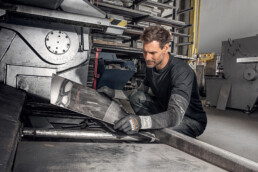
Here is an overview of the areas of application for which cut protection gloves are suitable:
- Food processing
- Police and other law enforcement organisations
- Wood processing
- Automotive industry
- Construction work & building industry
- Iron/steel industry
- Mining
- Glass handling
- Assembly
- Machine & tool construction
uvex has set itself the task of protecting people at work – from head to toe, from helmet to shoe. The competence and technology centre for hand protection is located in Lüneburg in northern Germany, where uvex safety gloves are researched, developed and produced. The importance of cut protection has long been recognised here, which is why the already well-stocked portfolio of safety gloves, which achieve cut-level status according to standards, has recently been expanded even further.
What does the EN 388:2016 cut protection standard say?
The standard that is decisive here is EN 388:2016, the European standard for protective gloves against mechanical risks, including cut protection. It specifies the requirements, test methods, labelling and manufacturer information for protective gloves. The letters A (low cut protection) to F (highest cut protection) are clearly defined as the result of the cut resistance test in accordance with EN ISO 13997. According to this, the durability of a glove against a sharp-edged object is determined by a single contact under high force. For this purpose, a long, straight blade is moved once over the test object. The minimum force to the average of the test specimen is determined after 20 millimetres. The result is given in Newtons (N) and assigned to a cut protection class accordingly.
| Cut level | A | B | C | D | E | F |
|---|---|---|---|---|---|---|
| Newton | ≥ 2 | ≥ 5 | ≥ 10 | ≥ 15 | ≥ 22 | ≥ 30 |
Important: If you are hesitating between two cut protection classes when purchasing gloves, opt for the higher protection if in doubt. This will prevent injuries.
uvex phynomic range provides first-class cut protection
The letters B to F can also be found in the product names of the uvex phynomic range – the new flagship glove from uvex. The name phynomic stands for the phenomenal ergonomic fit that all products have in common. But there are also some differences:
In addition to Cut Level B, which is included in the name, the uvex phynomic B XG offers excellent oil grip and touchscreen compatibility, which makes it attractive for use in precision assembly, precision and packaging work. This model is also available without the extra grip, i.e. without XG, but with an aqua-polymer foam coating as uvex phynomic B foam – ideal for the food industry, for example.
The uvex phynomic C5 offers a cut protection upgrade, which is also equipped with 45 per cent bio-based HPPE and is therefore produced in a particularly sustainable way. This model is also available in the XG version (i.e. with excellent oil grip) and with an ESD function that protects workpieces from electrostatic discharge.
The uvex phynomic F XG offers the highest cut protection, namely cut level F. This model should therefore be worn by anyone working with very sharp-edged parts, for example in metal or glass processing. It also protects against contact heat up to 100 degrees Celsius, is extremely durable and free from harmful substances. The uvex phynomic F XG combines first-class sensitivity with excellent grip and maximum cut protection.
As you have already realised, in addition to cut protection, the gloves also have other practical features. This is important because the sharp, metal or other objects that pose a danger in all the areas of application listed can also be hot, dirty, wet or oily.
Cut protection gloves: What materials does uvex use?
To ensure optimum protection, uvex relies on a sophisticated combination of innovative materials and advanced technologies. The focus is not only on hand protection, but also on the fit and comfort of the cut protection gloves. Below you will find an overview of the materials and technologies used that make uvex products so effective:
- Kevlar®
Kevlar is an extremely resistant para-aramid fibre that impresses with its outstanding heat resistance (up to +250°C), cut and abrasion resistance. These properties make it the ideal choice for demanding work situations. - Carbon fibre
Carbon is characterised by its exceptional strength, dimensional stability and low weight. It is made from plastic reinforced with carbon fibres and thus offers an optimum ratio of stability to lightness. - SuperFabric®
This material consists of tiny protective plates and offers cut protection levels A6 to A9 according to ANSI/ISEA 105-2016 – this even exceeds the highest European standards! HexArmor® gloves with SuperFabric® also offer protection against needlesticks and other sharp objects without restricting dexterity or breathability. - uvex 3D-Ergo
Thanks to this technology, users benefit from a precise fit, which is supported by the ergonomic shape, an elasticated aqua-polymer coating and a fine-knit liner made of polyamide and elastane. This combination ensures optimum cut protection and freedom of movement. - Bamboo TwinFlex® technology
This sustainable technology combines recycled polyamide with glass or steel fibres to achieve a high level of cut protection (level D) and abrasion resistance. The HPPE fibre provides additional tear resistance, while the bamboo yarn ensures a comfortable feel and a good glove climate. This technology can also be found in the uvex textreme cut collection, which offers abrasion and cut-resistant clothing such as polo shirts or shirts for additional forearm protection. - Dyneema® Diamond Technology
This technology not only improves cut protection, but also tear resistance. The microparticles embedded in the fibre, in combination with elastane, offer outstanding sensitivity and excellent dexterity – ideal for lightweight, cut-resistant gloves.
With these innovative technologies, uvex ensures that both comfort and protection are guaranteed for a wide range of applications.
Hand protection made in Germany
This is the claim of the Fürth-based family business, which is one of the largest manufacturers in the hand protection product group that still produces in Germany and Europe. In times when resources and transport capacities are scarce worldwide, this locational advantage is crucial for the availability and delivery of products.
At the same time, uvex retains control of the entire value chain: from the initial idea, through research and development, to manufacturing using state-of-the-art production processes. The uvex Bamboo TwinFlex D xg is a prime example of the innovative strength of uvex safety gloves, which also applies to the topic of cut protection. The cut protection glove has been on the market for some time and, as the name suggests, the glove is made to a large extent from bamboo viscose, a naturally renewable raw material. This component ensures a silky feel and rapid moisture absorption. The wearing comfort is correspondingly high, while the material also offers cut protection level D.
uvex also offers gloves that protect against chemical risks, impacts, punctures and the cold. So cut protection is by no means the only feature for which uvex in Lüneburg is working on ever better solutions. But it is a particularly important one. A look at the accident statistics shows this.
